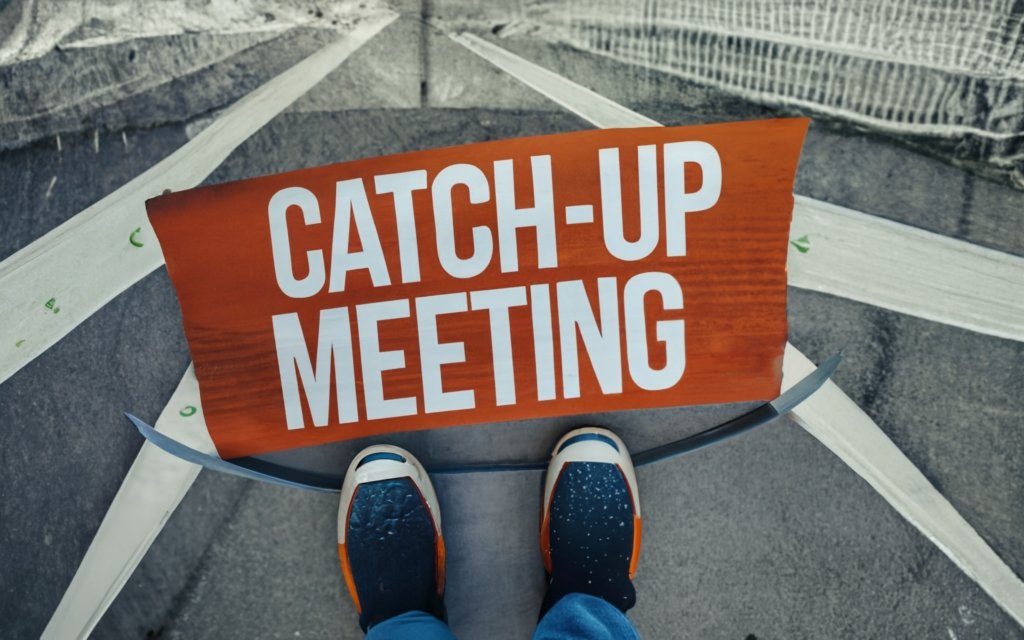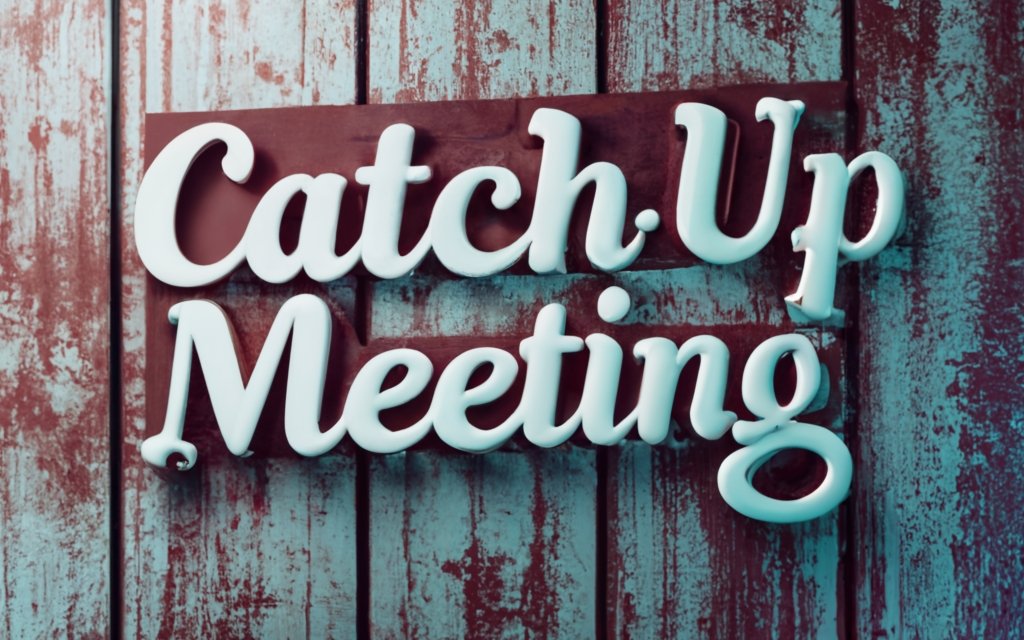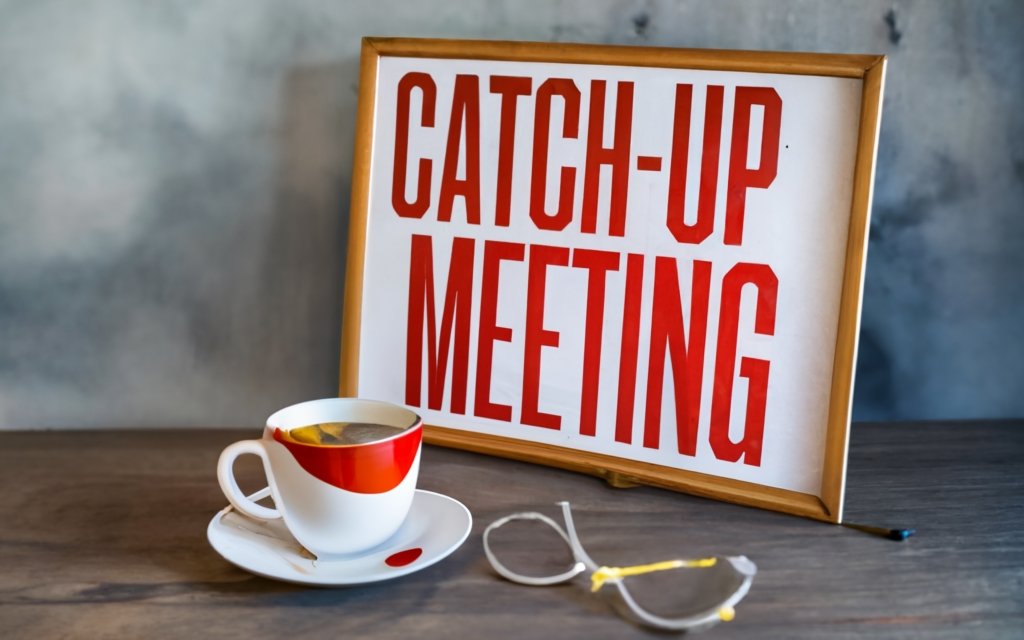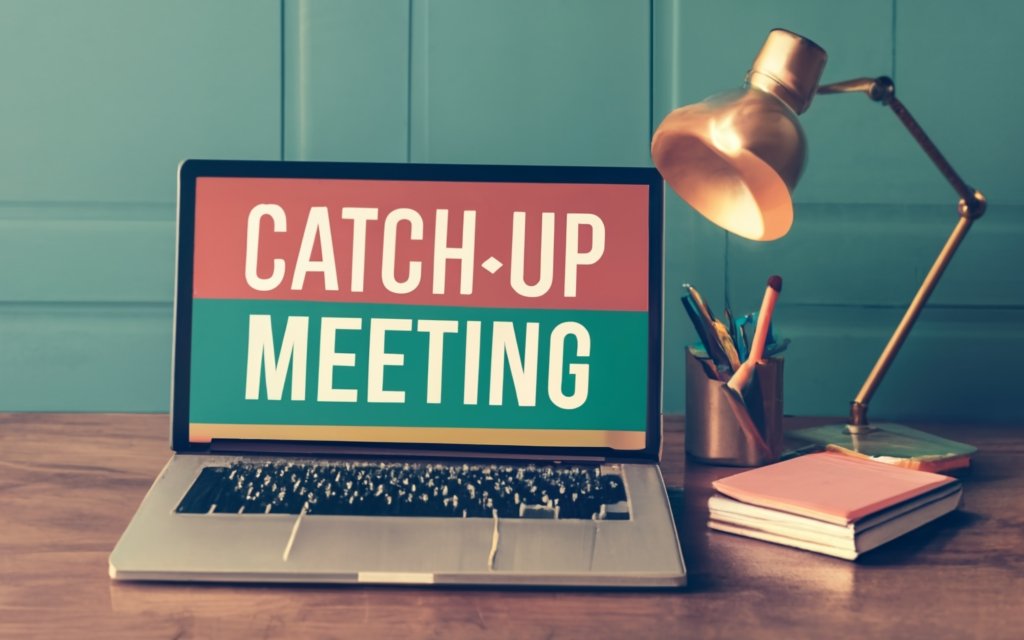Catch-up meetings. Love them or loathe them, these informal check-ins are a staple of workplace communication. But are they making your team more aligned, or just eating up precious hours in everyone’s calendar? Learn how to transform your catch-up meetings from boring to bold.
This comprehensive guide explores everything from creative formats to productivity tools to help take your recurring check-ins from time-wasters to team-builders. Soon you’ll look forward to catch-up meetings as engaging rituals that bring out the best in your people. So grab your favorite beverage, get comfortable, and let’s unlock the hidden potential in the humble – but powerful – catch-up meeting.
What is a Catch-Up Meeting?
In the busy day-to-day workflow, it can be easy to get siloed into individual tasks and lose alignment with the broader team. That’s where catch-up meetings come in.
A catch-up meeting is an informal gathering between colleagues who haven’t connected in a while. Unlike highly structured status meetings, catch-up meetings have a flexible, casual format for teammates to strengthen relationships.
Brief, Casual Check-Ins
Catch-up meetings are generally short, ranging from 15-30 minutes. They don’t have a rigid agenda, but rather provide a space to:
- Get brief updates on progress and blockers
- Share new ideas and innovations
- Vent frustrations in a safe space
- Celebrate wins and milestones
The tone is friendly and conversational. You chat about work matters, but there’s also room for personal check-ins too.
How was your weekend? How are you coping with the workload? It creates opportunity for emotional connections beyond the task-based discussions.
Improving Collaboration and Innovation
Research shows that employees who feel invested in at the a personal level have higher engagement. Catch-up meetings foster that inclusion, making people feel valued as more than just workers.
This leads to stronger intra-team relationships. According to a Gallup study, teams with engaged employees see 21% higher productivity.
By providing a platform for people to communicate freely, catch-up meetings also encourage innovation. People feel comfortable sharing creative ideas and voicing concerns early.
A Stanford study found that psychological safety increases team innovation by over 200%. Catch-up meetings promote that open, transparent culture.
AligningDistributed Teams
Catch-up meetings play an especially crucial role in distributed teams. According to a recent survey, remote workers feel less connected than on-site teams.
Short, recurring check-ins help dispersed team members align. Provide space to ask questions, review progress, and raise issues that may have been lost across time zones and virtual tools.
Sample Catch-Up Meeting Topics
Catch-up meetings don’t require heavy prep. But it helps to have some questions or discussion topics in mind:
- Weekend/life updates
- Current tasks and responsibilities
- Progress made this week
- Upcoming deadlines
- Pain points or blockers
- New ideas or innovations
- Feedback for each other
- Team dynamics and relationships
- Work-life balance
Recurring Cadence
To realize the full benefits, catch-up meetings should occur on a consistent cadence, such as weekly or bi-weekly.
Ad-hoc meetings on a sporadic basis defeat the purpose of regularly aligning the team. Consistent meetings establish trust and promote honest discussions.
According to Atlassian, teams that meet regularly show a 37% increase in performance. Establish a recurring, respectful cadence tailored to your team needs.
Blending Asynchronous and Real-Time
Catch-up meetings blend asynchronous and real-time communication.
Have people provide written updates via collaborative docs before each meeting. This way, everyone can review progress and come prepared with questions for the live discussion.
You save time while still getting face-to-face connections.
Virtual Catch-Up Meetings
Geography is no longer a barrier with video conferencing apps like Zoom, Microsoft Teams, etc. However, exclusively virtual teams miss out on organic interactions.
Blend virtual and in-person when possible. But for fully remote teams, occasionally gather in a virtual cafe or fun backdrop to spark creativity.
In nutshell
To recap, the hallmarks of an effective catch-up meeting include:
- Brief, casual check-ins
- Promotes psychological safety
- Fosters innovation and creativity
- Provides early issue detection
- Aligns distributed teams
- Blends asynchronous and real-time
- Consistent, recurring cadence
With a flexible format focused on people, catch-up meetings are a simple way to develop collaborative, high-performing teams.

Why Catch-Up Meetings Matter
It’s easy to dismiss catch-up meetings as unnecessary small talk that eats into the workday. However, when done right, these recurring informal check-ins deliver immense value for teams and organizations.
Let’s explore why catch-up meetings are so crucial for performance, productivity, and employee satisfaction.
1. Improves Communication and Transparency
Open and transparent communication is the lifeblood of high-performing teams. But in the rush of day-to-day individual tasks, important messages can get lost or siloed.
Catch-up meetings provide a recurring space for:
- Sharing project updates and milestones
- Voicing concerns early
- Spotlighting roadblocks or ambiguities
- Developing solutions collaboratively
According to Atlassian, teams that meet regularly for status updates reduce project risk by 29%. By keeping communication lines flowing, catch-up meetings surface issues early when they are still easy to resolve.
These discussions also reinforce transparency and inclusion. When team members have a voice, they feel more engaged and invested in company outcomes. Gallup found that highly engaged teams show 21% greater profitability.
2. Provides Support and Motivation
Beyond task-driven discussions, catch-up meetings also provide space for personal check-ins. They allow leaders to take the pulse of how people are coping.
Asking open-ended questions shows employees their well-being matters. Providing emotional support motivates teams and leads to higher retention.
Catch-up meetings are also an opportunity to recognize progress. Even quick wins deserve acknowledgement. This boosts morale and productivity – a study by BambooHR revealed that 74% of employees feel motivated after a reward or recognition.
Leaders can also use these discussions to uncover professional goals people are working towards. Then provide guidance for development, which is especially appreciated by millennials. Deloitte found that nearly two-thirds of this group view professional growth opportunities as a key workplace motivator.
3. Identifies Issues Early
An open, recurring forum encourages team members to share challenges early, before they snowball into bigger problems.
Maybe a project is veering off course, or unclear requirements are slowing progress. Perhaps someone is overloaded and needs help delegating. Or interpersonal frictions are simmering beneath the surface.
Whatever the issue, early detection leads to faster resolution. Catch-up meetings provide a safe space for raising red flags so they can be addressed in a timely manner. Unresolved conflicts sink teams – Harvard research found they can tank collaboration by up to 50%.
4. Develops Trust and Relationships
At their core, catch-up meetings are about making human connections beyond the task at hand.
Having relaxed, personal discussions builds trust between team members. And this interpersonal foundation motivates people to communicate openly about substantive work issues.
According to a Harvard study, when psychological safety is present, teams report 106% more ideas than low-trust groups.
Beyond trust, catch-up meetings allow individuals to discover shared interests and values. These personal bonds lead to increased cooperation. One study revealed that simply learning teammates’ hobbies made groups 20% more efficient at completing tasks.
Investing just a few minutes regularly to relate on a human level pays exponential dividends in team cohesion and performance.
Blend Asynchronous and Real-Time Connection
To maximize engagement during precious real-time minutes, blend asynchronous and synchronous communication:
Before the meeting
- Share written status updates and progress via docs
- Review goals and metrics
- Raise discussion points
During the meeting
- Clarify points and ask questions
- Problem-solve sticky issues
- Provide support and feedback
- Celebrate milestones
After the meeting
- Summarize action items and next steps
- Share highlights and meeting notes
This structured approach optimizes preparation, execution, and follow-through.
Remote Teams Need Connection
Catch-up meetings are especially critical for remote teams. Virtual workers often feel disconnected and struggle with reduced non-verbal cues.
Short video check-ins reinforcebonds between dispersed teammates. Remote teams with recurring touchpoints show improved performance across metrics:
- 20% increase in task completion
- 29% decrease in project risk
- 21% reduction in delivery delays
So while casual socializing may seem frivolous, it has a profound impact on communication, transparency, innovation, and productivity. In today’s dispersed workplace, catch-up meetings are more vital than ever.
In short
In short, consistent catch-up meetings unlock a multitude of benefits:
- Surfaces issues early
- Develops trust and relationships
- Provides support and motivation
- Improves transparency and communication
- Blend asynchronous and real-time connection
As leaders strive to build inclusive and results-driven cultures, the humble catch-up meeting should not be underestimated. It remains one of the most effective tools for aligning, engaging, and ultimately retaining high-performing teams.

Best Practices for Productive Catch-Up Meetings
Catch-up meetings offer immense value, but only if executed thoughtfully. Let’s explore some best practices to optimize these recurring check-ins.
Have a Flexible Agenda
A semi-structured agenda prevents catch-up meetings from meandering, while still allowing organic discussion.
Sample catch-up meeting agenda:
- Personal weekend updates
- Current workload and responsibilities
- Progress and milestones this week
- Upcoming deadlines and goals
- Pain points or blockers
- New ideas or innovations
- Ways to provide support
- Team dynamics and relationships
- Open discussion
Keep the agenda flexible rather than strict. The goal is to guide discussion while leaving room for people to raise other topics.
Collaborate on agenda items before each meeting so everyone has a voice in shaping the talking points.
Build in Time for Casual Conversation
Don’t underestimate the value of casual check-ins before diving into work matters. Starting with a personal question like “How was your weekend?” breaks the ice and eases people into conversations.
Taking a few minutes to relate as human beings first facilitates open and honest dialogue when work topics arise. It also reinforces psychological safety – according to Google, teams with high psychological safety generate 20-25% greater profitability.
Listen Actively and Offer Feedback
The responsibility flows both ways in catch-up meetings. Leaders should actively listen when team members speak up.
Pay full attention, maintain eye contact, nod along, and avoid distractions. Ask clarifying follow-up questions to show the person you care about what they’re saying.
Then offer honest feedback and input where appropriate. Provide recognition for wins and milestones celebrated. If someone raises a roadblock, brainstorm solutions collaboratively.
Active listening demonstrates leaders’ investment in people’s development and success.
Balance Information Sharing and Problem Solving
Catch-up meetings have dual purposes: information sharing and problem solving. Balance both elements.
Information sharing
- Progress on tasks and goals
- Department or company updates
- Current workload
- Personal anecdotes
Problem solving
- Identify and remove roadblocks
- Discuss ways to provide support
- Develop solutions collaboratively
- Strategize on upcoming projects
Splitting meeting time between both purposes keeps the discussions productive.
Follow Up with Action Items and Notes
The true measure of an effective catch-up meeting is if discussion translates into action. So always conclude by:
- Reviewing key discussion points and decisions
- Documenting action items with owners and timelines
- Sharing highlights and notes with the wider team
This follow-up reinforces alignment around next steps and enables anyone unable to attend the meeting to still stay informed.
According to leadership expert Dan Rockwell, 70% of decisions made in meetings aren’t acted upon because of inadequate follow-up. Don’t fall into that trap.
Sample Follow-Up Email
Here is a sample follow-up email after a catch-up meeting:
Subject: Catch-Up Meeting Notes
Hi Team,
Thank you for the engaging catch-up meeting today. Here are some quick highlights and next steps:
Key Discussion Points
- Customer onboarding process improvements
- New client engagement strategy
- Q4 sales goal progress
Action Items
- Sarah: Share proposed onboarding workflow by Fri
- Mark: Draft outline for new client engagement strategy by Mon
- All: Submit Q4 sales projections by Wed
Please let me know if I missed anything. Looking forward to connecting again in next week’s catch-up meeting!
Best,
[name]
Virtual Catch-Up Meetings
In remote teams, catch-up meetings happen virtually. But staring at a screen can feel sterile compared to in-person interactions.
Occasionally switch up the backdrop – offer a window into your home life to spark conversation. Or use a virtual background like a cafe or beach to liven things up.
Also take advantage of video call features. Share screens or documents for collaborative review. Use digital whiteboards to brainstorm together. Leverage polls, chat and annotations to keep everyone engaged.
With a little creativity, virtual catch-up meetings can still facilitate personal connections and efficient discussions despite physical distance.
In nutshell
To summarize, the keys to productive catch-up meetings include:
- Create a flexible agenda
- Start with casual check-ins
- Listen actively and share feedback
- Balance information and problem-solving
- Follow up with clear next steps
- Incorporate interactive elements into virtual meetings
Keep these best practices in mind to help recurring catch-up meetings strengthen relationships, alignment, and performance across your team.

Catch-Up Meeting Templates
Well-structured templates help optimize catch-up meetings while still allowing for organic discussion. Here are some sample templates to guide your preparation.
Catch-Up Meeting Agenda Template
Here is an adaptable agenda outline you can customize for your recurring check-ins:
Catch-Up Meeting Agenda
Date:
Time:
Attendees:
Personal Check-In
- Weekend / life updates
- Current mood and workload
Individual Updates
- Progress and milestones
- Upcoming deadlines and plans
- Blockers
Team Check-In
- Team dynamics and relationships
- Ways to improve collaboration
- Open discussion and ideas
Support and Feedback
- Recognition and appreciation
- Constructive criticism
- Ways to provide support
Next Steps
- Review actions
- Schedule next meeting
Tweak the talking points based on your team and discussion goals. The sections provide helpful framing while allowing flexibility.
Collaborate on agenda items in a shared doc so everyone has input. And set a time limit to keep the meeting contained.
With an agenda as a guide, catch-up meetings stay focused yet conversational.
Catch-Up Meeting Follow-Up Email Template
Here is a sample follow-up email template to circle back on action items:
Subject: Catch-Up Meeting Follow-Up
Hi [Team],
Thank you for the productive catch-up meeting today! Here is a quick recap of what we discussed and next steps:
Key Discussion Points
- [E.g. New project scope and timeline]
- [E.g. Client onboarding improvements]
Action Items
- [Name]: [Action item] by [Due date]
- [Name]: [Action item] by [Due date]
Please let me know if I missed anything. Looking forward to connecting again in our next catch-up meeting on [date]!
Best,
[Your name]
Sharing highlights and follow-ups ensures alignment and accountability on next steps. Customize the template to reflect your specific discussion and action items.
Catch-Up Meeting Minutes Email Template
For more formal documentation, you can also summarize catch-up meetings in an email with minutes:
Subject: Catch-Up Meeting Minutes
Date: [Meeting date]
Time: [Meeting time]
Attendees: [List attendees]
Agenda:
- [Agenda item 1]
- [Agenda item 2]
- [Etc.]
Meeting Notes & Action Items
[High-level summary of what was discussed]
Key Decisions:
- [Decision 1]
- [Decision 2]
Action Items:
- [Name]: [Action item] by [Due date]
- [Name]: [Action item] by [Due date]
Other Notes:
[Any other notes]
Please review and let me know if I missed or misrepresented anything. I look forward to connecting again in our next catch-up!
[Your name]
This more thorough template captures vital details and discussion points for future reference. Adjust to suit your needs.
Recurring Cadence
To ingrain consistency, set catch-up meetings to recur automatically on a set interval, such as weekly or biweekly.
Recurring meetings reduce the effort of rescheduling. It also sets expectations so people can reliably prepare and make time for each check-in.
According to the Hay Group, up to 70% of meetings lack well-defined objectives and agendas. So take advantage of templates to keep your valuable catch-up time structured and focused.
Virtual Catch-Up Meetings
When meetings are virtual, leverage technology to keep everyone engaged:
- Use video and screen sharing for visual collaboration
- Take live meeting notes and share recaps
- Send reminders and calendar invitations
- Incorporate interactive polls, annotations, whiteboards etc.
With the right preparation and templates, productive catch-up meetings can thrive no matter the location.
In short
In summary, these catch-up meeting templates ensure you:
- Have a loose agenda to guide discussion
- Follow up on action items and decisions
- Document meeting minutes for records
- Set consistent recurrence cadence
- Incorporate interactive elements into virtual meetings
Leverage these templates as a starting point, then customize to suit your team’s needs and build even stronger alignment through recurring check-ins.

Tips for an Effective Catch-Up Meeting Cadence
Consistency is crucial when establishing a productive cadence for recurring catch-up meetings. Here are some tips to find the ideal frequency for your team.
Consistency is Key
The most fundamental tip is to stick to a consistent, predictable schedule for catch-up meetings. Common intervals are weekly or bi-weekly.
Whatever frequency you choose, consistency helps:
- Ingrain meeting habits
- Ensure people make time and prepare
- Enable issues to be surfaced regularly
According to leadership coach Dan Rockwell, “When meetings are regular, people show up prepared. When meetings are scheduled randomly, 50% of the meeting is wasted figuring out what to talk about.”
So find a cadence that works for your team, then commit to maintaining it barring holidays or emergencies. Consistency builds trust and engagement over time.
Balance Team Needs
When deciding on frequency, strike a balance between being overly-eager and too aloof:
Too Frequent
- Meeting overload
- Little progress between meetings
- Reduced productivity
Too Infrequent
- Lack of communication and alignment
- Issues remain unaddressed
- Relationships weaken
The ideal lies in the middle – meeting often enough to collaborate effectively but not so often that your schedule becomes crowded.
Consider Team Size
Team size plays a role in appropriate meeting frequency. According to leadership expert Joel Peterson, larger teams benefit from more touchpoints to ensure everyone feels connected and heard.
So the cadence for a 5-person team may differ from a 20-person team. Here are some general guidelines:
1-5 people – Every 1-2 weeks
5-10 people – Weekly
10+ people – Twice weekly
Adjust based on your team dynamics and needs. Also factor in if your team is remote, as virtual teams require more frequent alignment.
Individual vs. Group Meetings
For managers, you may layer 1-on-1 employee meetings into your cadence in addition to teamwide meetings.
Many leaders have weekly catch-ups with direct reports. This provides dedicated time to develop those relationships and review progress.
Group meetings keep the entire team looped in on broader company updates. Find the right mix of both formats tailored to your objectives.
Reminders Help Avoid Cancellations
With busy schedules, meetings easily fall through the cracks. But cancellations disrupt your cadence consistency.
According to the Hay Group, up to 15% of recurring meetings are cancelled each week.
You can reduce cancellations by:
- Sending calendar invites with all meeting recurrences upfront
- Emailing reminders the day before
- Establishing meeting habits and expectations
Technology like calendar syncing and automated reminders also help meeting adherence. Don’t let a cancelled catch-up ruin your cadence.
Sample Weekly Cadence
Here is a sample weekly cadence incorporating some of these tips:
Monday
- Team Catch-Up Meeting (30 min)
Tuesday
- 1-on-1 with Direct Reports (30 min each)
Wednesday
- Department Catch-Up Meeting (30 min)
Thursday
- 1-on-1 with Direct Reports (30 min each)
Friday
- Team Catch-Up Meeting (30 min)
This blends both team and 1-on-1 meetings for broad and focused check-ins. The twice weekly team catch-ups provide consistency, while the 1-on-1s give dedicated development time.
Recurring Doesn’t Mean Identical
Just because your catch-up meetings recur consistently doesn’t mean they must follow the exact same agenda and format each time.
Incorporate variety to keep things fresh:
- Rotate facilitators
- Change up the agenda
- Try new virtual meeting activities
- Mix individual and group discussions
Maintain the rhythm while sprinkling in creativity.
In nutshell
In summary, tips for optimizing your catch-up meeting cadence include:
- Commit to a consistent frequency
- Balance team needs in choosing interval
- Factor in team size and structure
- Use reminders to prevent cancellations
- Blend both group and 1-on-1 meetings
- Incorporate variety into recurring meetings
With the right cadence, your team can look forward to catch-up meetings as a reliable forum for aligning and engaging.

Alternatives to Catch-Up Meetings
While valuable, catch-up meetings shouldn’t become the default for every work communication. Here are some alternatives to consider balancing out meetings.
Written Status Updates Via Email/Docs
For straightforward progress updates, written communication like emails or shared docs can suffice.
Compared to meetings, written updates provide:
- Accessibility: Documented updates don’t get lost like verbal ones. People can reference them later.
- Visibility: Written updates keep everyone looped in, even people who miss meetings.
- Accountability: Documenting status reinforces people follow through on tasks.
- Flexibility: People can digest updates on their own time asynchronously.
According to leadership expert Liz Wiseman, “Email is for information transfer. Meetings are for human connection.” Keep that distinction when deciding between meetings and email.
For quick status checks, have team members submit bulleted updates before the week’s catch-up meeting. Compile them into a shared doc everyone can review.
Then in the meeting, dive right into problem solving and relationship building with context already established.
Recorded Video Updates
Like written updates, recorded videos are another asynchronous alternative if people don’t require real-time interaction.
Tools like Loom make it simple to capture quick webcam updates that recap:
- Recent progress
- Current blockers
- Support needed
- Upcoming plans
Videos humanize communication through body language and tone. Recordings also reduce ambiguity compared to just text.
Loom reports that teams react 60% faster to video updates vs. written messages.
For distributed teams, video updates approximate in-person interactions better than meetings relying purely on stilted audio. Sprinkle these personal check-ins between standard catch-up meetings.
Instant Messaging for Quick Questions
Instant messaging platforms like Slack enable you to get rapid responses to quick questions rather than wait for the next scheduled meeting.
Immediate back-and-forth in chat replaces tedious email chains. Plus chat communication is easier to search than fragmented meeting recaps.
According to joining.com, Slack users save up to 4.6 hours per employee each week by switching from email to messaging.
However, don’t let instant messaging replace deeper discussions better suited for meetings. Use it for limited, non-urgent issues between check-ins.
Kanban Boards and Collaboration Tools
Visual collaboration apps provide ongoing transparency into what people are working on day-to-day rather than periodic updates in meetings.
With kanban-style boards like Trello, team members can:
- Break projects into digestible tasks
- Visually map workflow process
- Update progress in real-time
- Comment and collaborate
There’s no need for perfunctory status meetings when everyone has an accurate, live view into teamwork.
According to tech writer David Kadavy, kanban boards can boost team productivity by 20-30%. They provide visibility and accountability between meetings.
Balance Meetings and Alternatives
The goal isn’t to eliminate catch-up meetings, which provide other benefits like relationship building. But offsetting some status updates reduces unproductive time together.
When weighing meetings vs. alternatives, consider:
Use meetings for:
- Cross-functional collaboration
- Complex problem solving
- Building relationships and inclusion
Use asynchronous methods for:
- Information sharing
- Quick questions and clarifications
- Light status updates
- Ongoing project transparency
In nutshell
In summary, complement your recurring catch-up meetings with:
- Written status updates over email/docs
- Asynchronous video recordings
- Instant messaging for quick clarifications
- Kanban boards and collaboration tools
Blending other formats gives people flexibility in how they communicate and align. The future of work is about choice when and how people engage. Empower teams with options beyond an endless parade of meetings.

When to Have a Meeting vs. Email Update
With busy schedules, it’s important to choose the right communication format – meeting or email – for each situation. Here are tips on when to use each channel.
Meetings
Reserve real-time meetings for:
Cross-functional collaboration
Issues involving multiple teams with different perspectives are best discussed interactively.
Meetings allow viewpoints to be shared and synthesized to find solutions. Trying to loop in different groups strictly via email chains can get messy.
Complex problems or projects
Intricate issues with lots of moving parts and ambiguity require the dynamic back-and-forth of meetings to map out plans.
Email only captures snapshots. Meetings provide a space to grapple with fluid, gray areas in real-time together.
Relationship building
Human connections strengthen via the social interactions of meetings. Nonverbal cues and free-flowing conversations build relationships critical for team cohesion.
Email efficiency over personalized interaction can harm team trust and morale over time.
For straightforward information sharing, announcements, and simple logistics, email works better than meetings:
Information sharing
Rather than verbally repeat the same updates meeting after meeting, compile them into an accessible email, document, or spreadsheet.
Written updates allow people to reference details again if needed.
Announcements
Important news that requires little discussion is easily disseminated through email blasts.
Mass emails ensure everyone receives the message while avoiding unnecessary large meetings rehashing the same points.
Simple logistics
Scheduling or minor plans involving a few people can be efficiently arranged over email rather than a meeting. Email provides a clear chain of agreed details.
Of course, impromptu discussions may still be necessary at times for urgent issues. But for non-pressing matters, aim for email first.
Examples
Consider these scenarios when weighing meetings versus emails:
Meeting:
- Brainstorming new product features across departments
- Spreading holiday team event planning across multiple people
- Relationship building happy hour
Email:
- Sending new brand guidelines info
- Scheduling 1-on-1 manager check-ins
- Distributing last week’s sales report
Meetings provide collaboration and connection, while emails enable efficient broadcasting.
In nutshell
In summary, leverage:
Meetings for:
- Cross-functional collaboration
- Complex issues or projects
- Relationship building
Email for:
- Information sharing
- Announcements
- Simple logistics
Apply these guiding principles to choose the best format for each situation. Avoid defaulting to meetings when email may suffice. But also recognize meetings’ unique collaborative benefits compared to email chains in silos.
Pick the right tool for the job and watch your team’s alignment, productivity and job satisfaction prosper.

Tools and Software to Enhance Catch-Up Meetings
Technology can help take recurring catch-up meetings to the next level. Here are some tools to streamline scheduling, execution, and follow-up.
Calendar Syncing
The foundation for consistent catch-up meetings is keeping calendars in sync. With access to everyone’s availability, scheduling regular meetings is seamless.
Tools like Google Calendar](https://calendar.google.com/) and [Outlook Calendar make calendar sharing and visibility easy.
Additional software like Reclaim takes this a step further by automatically finding times that work for everyone right from your calendar.
With calendars in sync, say goodbye to the tedious back-and-forth of finding common free time.
Video Conferencing
When meetings go virtual, reliable video conferencing software keeps the conversations face-to-face.
Leading options include:
- Zoom
- Google Meet
- Microsoft Teams
- GoToMeeting
These apps make it easy to connect visually on any device. Useful features include screen sharing, digital whiteboards, and custom virtual backgrounds.
However, brief catch-ups don’t require elaborate video production. Don’t let clunky video software sap the casual vibe.
Note Taking and Summaries
It’s challenging to recall everything discussed without documented notes and reminders. But scribbling meeting minutes steals focus from engaging in the conversation.
Tools like Otter.ai](https://otter.ai/) solve this by automatically transcribing meetings and generating shareable meeting notes. Others like [Fireflies even create concise meeting summaries from the transcription.
Having an AI assistant handle note-taking frees people to be present and participatory during precious facetime.
Follow Up Reminders
The key to meetings translating into action is consistent follow-up. But it’s easy to let assigned tasks slip through the cracks.
Reminder apps like Todoist ](https://todoist.com/)and [Google Tasks help you remember to complete the items you promised.
For extra assurance, use Boomerang’s scheduling features to get automatic email reminders to circle back on action items by certain deadlines.
With friendly nudges, your team will come through on meeting commitments.
Productivity Suites
Rather than piecing together disparate apps, productivity suites like ClickUp](https://clickup.com/) and [Notion consolidate your workflow.
These all-in-one platforms offer:
- Document collaboration
- File sharing
- Task management
- Calendar integration
- Video conferencing
- Chat messaging
With tools tightly synced, you optimize before, during, and after meeting productivity all from one centralized hub.
Sample Suite Tech Stack
A sample tech stack to streamline catch-up meetings leveraging productivity suites might include:
Scheduling
- Reclaim for intelligent calendar booking
- Zoom for video conferencing
Execution
- Otter.ai for automatic meeting notes
- Miro for visual collaboration
Follow Up
- ClickUp tasks for assigning action items
- Boomerang for reminders
Curate your own optimized tech stack catered to how your team works best.
In nutshell
Catch-up meetings thrive with the right technology:
- Calendar sharing for easy scheduling
- Video conferencing with interactive features
- Note taking and summaries to document discussions
- Task management with reminders for follow through
- Consolidated productivity suites
While not required, tools that automate and streamline the catch-up meeting workflow help unlock the full value of this impactful recurring sync.

Key Takeaways for Productive Catch-Up Meetings
Let’s recap the core principles to ensure your recurring check-in meetings strengthen relationships, alignment, and performance across your team.
Value Everyone’s Time
With packed calendars, every meeting should be a worthy investment of the team’s limited time. As leadership consultant Liz Wiseman notes, “Great leaders see their primary purpose as providing clarity, focus and energy.”
Catch-up meetings give leaders face time to realign and motivate. But without thoughtful preparation and facilitation, they easily degrade into wheel-spinning sessions that sap energy.
So value attendees’ time by:
- Having a clear purpose
- Following an agenda
- Starting and finishing on time
- Following up on action items
With focused value-add, team members will eagerly anticipate check-ins rather than dread more aimless meetings.
Have a Clear Objective
Defining the objective upfront gives direction and sets expectations. Recurring catch-up objectives might include:
- Strengthening relationships
- Fostering transparency
- Tracking progress
- Removing roadblocks
- Exchanging feedback
With a stated objective, you can then shape relevant discussion topics and prep materials like agendas. According to the Harvard Business Review, while 65% of senior managers view meetings as unproductive, only 5% take time to define the purpose. Don’t fall into that trap.
Utilize Tools to Enhance and Automate
Work smarter by tapping tools that streamline scheduling, note taking, and follow up. The right software also adds valuable interactive elements.
Effective solutions to incorporate include:
Before
- Calendar sharing
- Video call links
- Agenda collaboration
- Asynchronous pre-reads
During
- Automatic transcriptions
- Interactive whiteboards
- Live sentiment polls
After
- Note summaries
- Action items and reminders
- Recurring cadence
Automation technology alleviates the tedious logistics so leaders can focus on the human connection.
Experiment with Formats
While the recurring rhythm is key, remix the catch-up format to sustain energy:
- Change up the agenda focus
- Rotate facilitators
- Mix individual and group check-ins
- Freshen virtual venues
- Incorporate quick collaborative activities
Keep things fresh while retaining continuity by judiciously shaking up the formula.
Psychological research shows that activities we anticipate induce more engagement than ones that become routine. So offer participants something new to look forward to.
Blend Real-Time and Asynchronous
Catch-up meetings provide invaluable face-to-face rapport. But balance out real-time interactions by:
- Sharing pre-reads before each check-in
- Following up afterward with recaps and notes
- Incorporating quick video updates between meetings
- Posting status updates via shared docs
According to leadership coach David Grossman, blended communication “leverages the power of both synchronous and asynchronous.” Preparation and follow-through stages bookend quality time together.
Sample Blended Cadence
A sample cadence integrating these blended principles could be:
Monday
- Before – Status updates pre-read
- During – 30 minute group video call
- After – Recap email with action items
Thursday
- Before – Progress checkpoint via Slack
- During – 20 minute 1-on-1 video call
- After – Todoist tasks assigned
This blends asynchronous updates with valuable real-time interactions.
In nutshell
To recap, optimize catch-up meetings by:
- Valuing everyone’s time
- Having a clear objective
- Incorporating automation tools
- Keeping meetings fresh
- Blending asynchronous and real-time communication
With these principles, recurring check-ins evolve into engaging rituals team members look forward to rather than dread.
Catch-up meetings seem simple, but their impact on alignment, transparency, and job satisfaction make them a pillar of productive teams. Treat them as such by incorporating these key takeaways.
Summary
Catch-up meetings are a simple yet powerful way to engage teams, drive transparency, and promote productivity. Here are the key takeaways:
- Have a flexible agenda to guide discussion while allowing organic flow.
- Build relationships and psychological safety by blending personal and professional check-ins.
- Listen actively, offer feedback, and exchange recognition and support.
- Balance information sharing with problem solving and decision making.
- Follow up with clear action items, highlights, and notes to maintain alignment.
- Establish a consistent cadence tailored to team needs, like weekly or bi-weekly.
- Incorporate interactive elements into virtual meetings to keep them collaborative.
- Alternate catch-up formats to retain energy and freshness.
- Blend asynchronous updates via email/docs with real-time dialog.
- Streamline logistics with calendar sharing, video tools, note taking apps and more.
- Keep meetings focused and valuable by handling simple updates via other means.
By optimizing these recurring check-ins, leaders can realize immense benefits in communication, innovation, and job satisfaction across their teams. When executed thoughtfully, the humble catch-up meeting becomes a lynchpin to high performance.
Frequently Asked Questions
What is the ideal length for a catch-up meeting?
Aim for 15-30 minutes. This keeps the meeting focused while allowing enough time for quality discussions. Be sure to start and end on time.
How often should catch-up meetings occur?
Typically every 1-2 weeks, but adjust based on team needs. Smaller teams may need more frequent touchpoints, while large teams could do well with twice per month.
Should you have an agenda for casual catch-up meetings?
A flexible agenda helps guide discussion while still allowing for organic flow. Share it ahead of time for visibility into talking points.
How do you make virtual catch-up meetings more engaging?
Incorporate interactive elements like polls, screen sharing, whiteboards and fun backgrounds. Use video to pick up on nonverbal cues.
What if action items from the previous meeting weren’t completed?
Surface these early in the next meeting to remove roadblocks collaboratively. Reset expectations going forward to improve follow-through.
How do you keep catch-up meetings productive and focused?
Have a clear objective, prepare an agenda, follow up afterward, start/end on time. Politely redirect off-topic tangents.
What if meetings consistently run over the scheduled time?
Refine your agenda to ensure you’re prioritizing the most important items given the limited window. Extending meetings strains peoples’ time and patience.
Should you take formal notes and minutes during casual check-ins?
Summarize key takeaways afterward via email or shared doc. Assign action items with owners and deadlines. But avoid formal minute-taking during the meeting itself.
What topics are suitable for a catch-up meeting?
Work updates, progress, goals, challenges, ideas, feedback, relationships, morale, Wellness, plans, questions, and open discussions.

